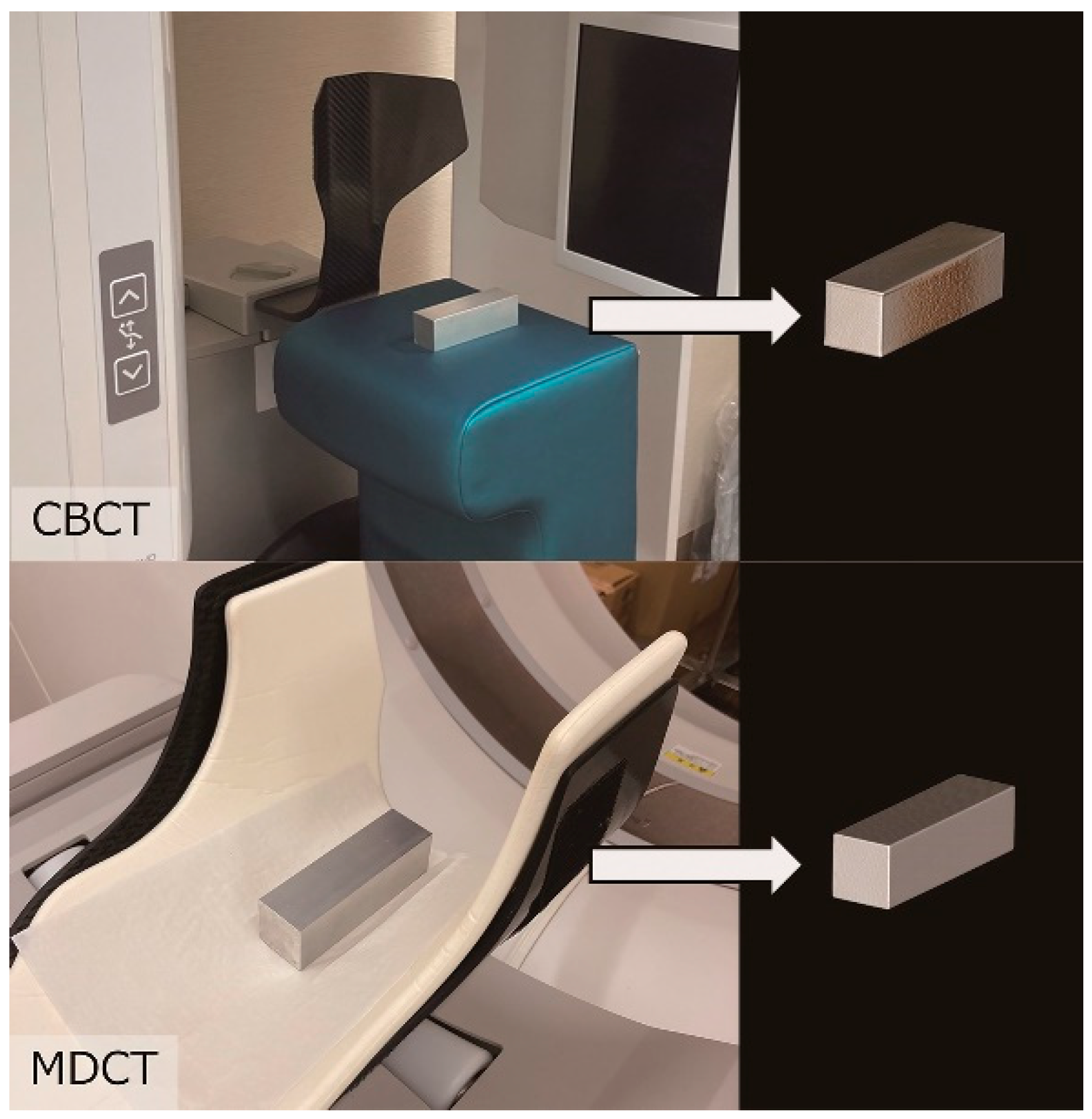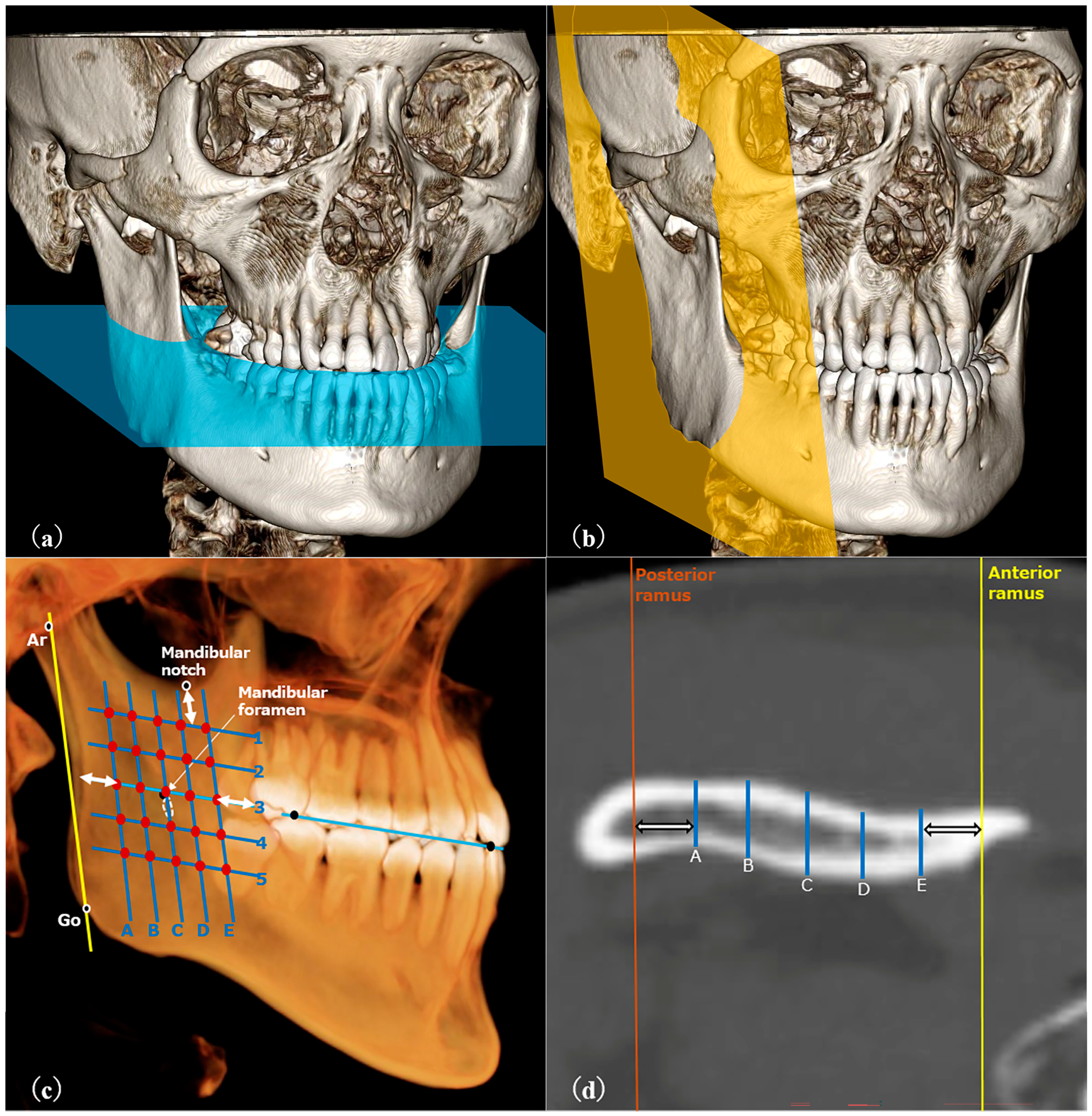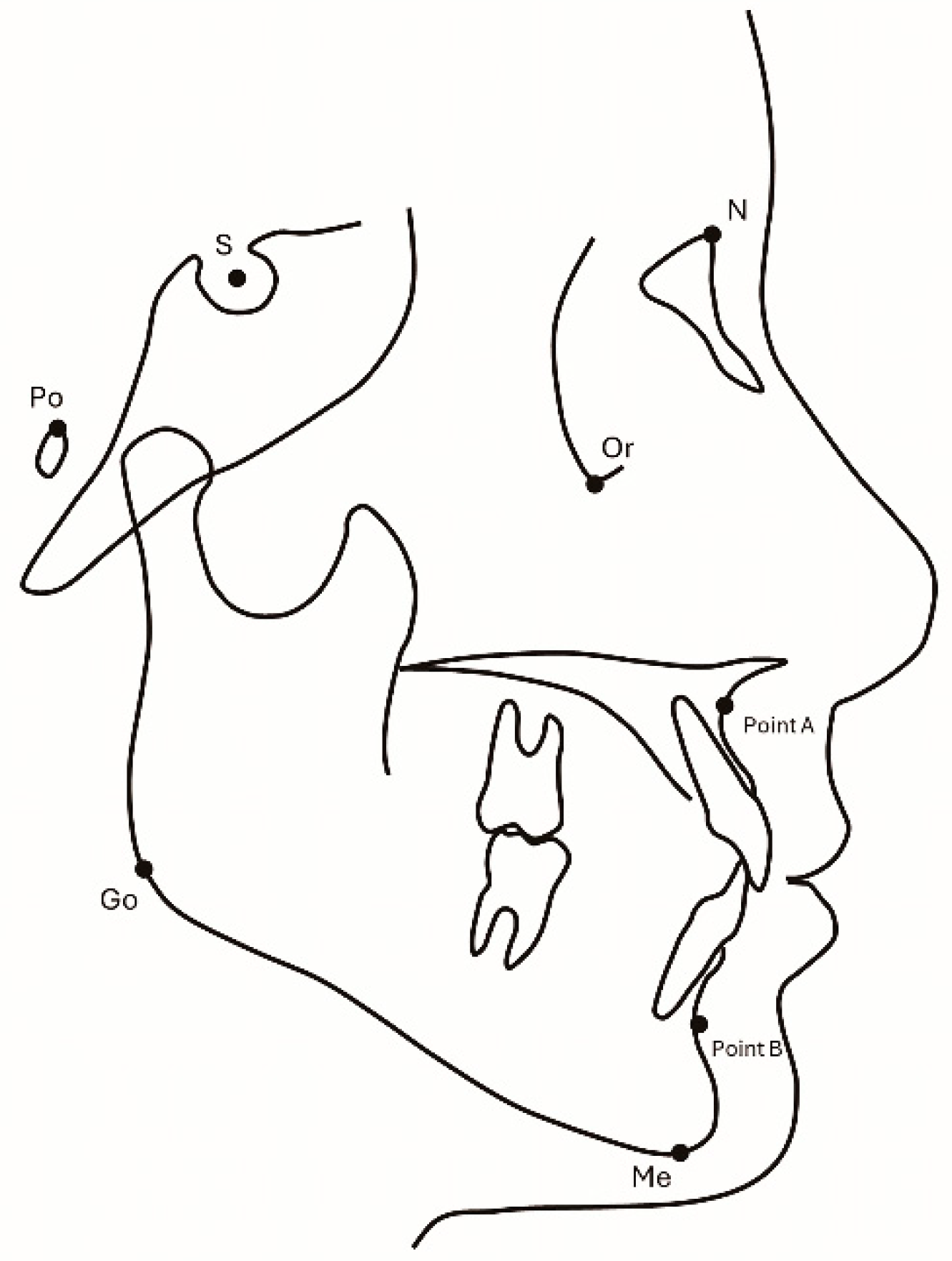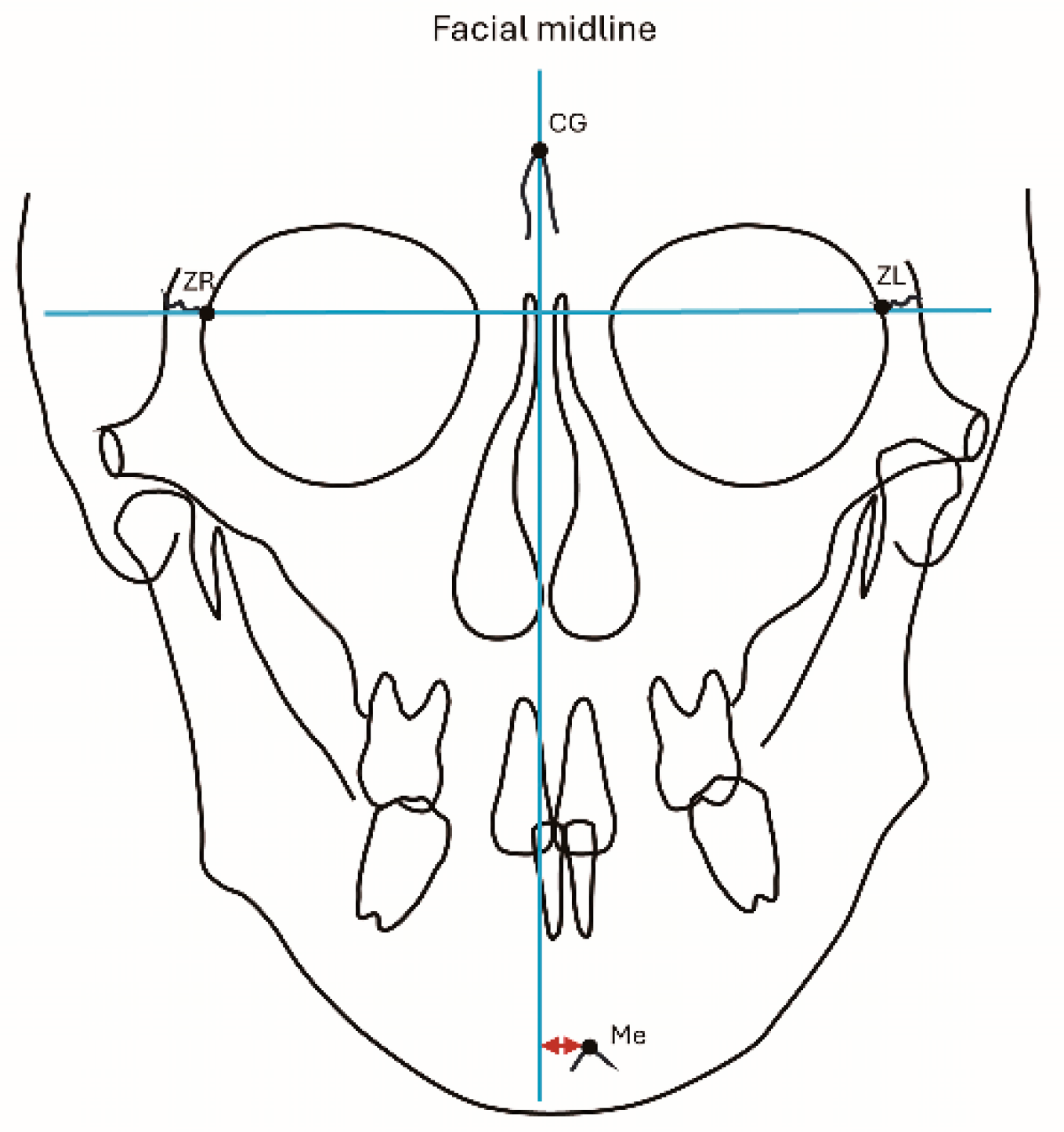The Role of Mandibular Thickness in Determining Anteroposterior Skeletal Relationships
Abstract
1. Introduction
2. Materials and Methods
- Adults aged 18 years or older;
- No congenital disorders (diseases that affect the craniofacial region, such as cleft lip and palate, cleft jaw, and Down syndrome) or systemic diseases (patients with a history of trauma to the craniofacial region, cysts or tumors, periodontal disease, or diseases that are causally related to diabetes);
- No mandibular deviations (0 mm ≤ Me deviation ≤ 2 mm);
- Skeletal Class I, Class II, or Class III.
- Individuals with congenital disorders;
- Individuals with systemic diseases;
- Individuals aged < 18 years;
- Individuals with mandibular deviations (2 mm < Me deviation).
2.1. Measurements
2.2. Statistical Analysis
3. Results
4. Discussion
Limitation
5. Conclusions
Author Contributions
Funding
Institutional Review Board Statement
Informed Consent Statement
Data Availability Statement
Acknowledgments
Conflicts of Interest
References
- Breeland, G.; Aktar, A.; Patel, B.C. Anatomy, Head and Neck, Mandible. In StatPearls [Internet]; StatPearls Publishing: Treasure Island, FL, USA, 2024. [Google Scholar]
- Arqub, S.A.; Al-Zubi, K.; Iverson, M.G.; Ioannidou, E.; Uribe, F. The biological sex lens on early orthopaedic treatment duration and outcomes in Class III orthodontic patients: A systematic review. Eur. J. Orthod. 2022, 44, 311–324. [Google Scholar] [CrossRef] [PubMed]
- Baccetti, T.; Franchi, L.; McNamara, J.A. Treatment and posttreatment craniofacial changes after rapid maxillary expansion and facemask therapy. Am. J. Orthod. Dentofac. Orthop. 2000, 118, 404–413. [Google Scholar] [CrossRef]
- DiBiase, A.T.; Seehra, J.; Papageorgiou, S.N.; Cobourne, M.T. Do we get better outcomes from early treatment of Class III discrepancies? Br. Dent. J. 2022, 233, 197–201. [Google Scholar] [CrossRef] [PubMed]
- Jiménez-Silva, A.; Carnevali-Arellano, R.; Vivanco-Coke, S.; Tobar-Reyes, J.; Araya-Díaz, P.; Palomino-Montenegro, H. Craniofacial growth predictors for class II and III malocclusions: A systematic review. Clin. Exp. Dent. Res. 2021, 7, 242–262. [Google Scholar] [CrossRef] [PubMed]
- Lyu, H.; Ma, H.; Wang, X.; Xu, L.; Hou, J.; Zhao, Y.; Li, W.; Li, X. Three-dimensional assessment of periodontal support of lower incisors for skeletal Class II malocclusion undergoing presurgical orthodontic treatment with different vertical skeletal patterns. Prog. Orthod. 2023, 24, 45. [Google Scholar] [CrossRef] [PubMed]
- Tseng, Y.C.; Liang, S.W.; Chou, S.T.; Chen, S.C.; Pan, C.Y.; Chen, C.M. Differences in the Buccal Bone Marrow Distance of ≤0.8 mm in the Mandible of Patients Undergoing Sagittal Split Ramus Osteotomy among the Different Skeletal Patterns: A Retrospective Study. J. Clin. Med. 2021, 10, 5644. [Google Scholar] [CrossRef]
- Katayama, K.; Yamaguchi, T.; Sugiura, M.; Haga, S.; Maki, K. Evaluation of mandibular volume using cone-beam computed tomography and correlation with cephalometric values. Angle Orthod. 2014, 84, 337–342. [Google Scholar] [CrossRef] [PubMed]
- Kusnoto, B.; Figueroa, A.A.; Polley, J.W. A longitudinal three-dimensional evaluation of the growth pattern in hemifacial microsomia treated by mandibular distraction osteogenesis: A preliminary report. J. Craniofac. Surg. 1999, 10, 480–486. [Google Scholar] [CrossRef]
- Meher, J.; Khan, S.H.; Abhishek Prasad, K.S.; Dixit, C.; Singh, R.K. Masseter Muscle Thickness in Relation to Facial Form in Angle’s Normal Occlusion and Malocclusions: An Observational Study. J. Pharm. Bioallied. Sci. 2024, 16 (Suppl. 1), S889–S893. [Google Scholar] [CrossRef]
- Saker, A.A.; Mousa, M.M.; Hajeer, M.Y.; Haddad, I.; Alhaffar, J.B.; Youssef, M. A Comparison Between Skeletal Class II and Class III Malocclusion Patients in Terms of the Masticatory Muscles’ Activity: A Cross-Sectional Study. Cureus 2024, 16, e59861. [Google Scholar] [CrossRef]
- Yeung, A.W.K.; Wong, N.S.M.; Li, D.T.S.; Lo, T.H.Y.; Leung, Y.Y. Is there a difference between the thicknesses of the rami in mandibular asymmetry? Int. J. Oral Maxillofac. Surg. 2021, 50, 791–797. [Google Scholar] [CrossRef] [PubMed]
- Maspero, C.; Farronato, M.; Bellincioni, F.; Cavagnetto, D.; Abate, A. Assessing mandibular body changes in growing subjects: A comparison of CBCT and reconstructed lateral cephalogram measurements. Sci. Rep. 2020, 10, 11722. [Google Scholar] [CrossRef] [PubMed]
- Nakawaki, T.; Yamaguchi, T.; Tomita, D.; Hikita, Y.; Adel, M.; Katayama, K.; Maki, K. Evaluation of mandibular volume classified by vertical skeletal dimensions with cone-beam computed tomography. Angle Orthod. 2016, 86, 949–954. [Google Scholar] [CrossRef]
- Swasty, D.; Lee, J.; Huang, J.C.; Maki, K.; Gansky, S.A.; Hatcher, D.; Miller, A.J. Cross-sectional human mandibular morphology as assessed in vivo by cone-beam computed tomography in patients with different vertical facial dimensions. Am. J. Orthod. Dentofac. Orthop. 2011, 139 (Suppl. 4), e377–e389. [Google Scholar] [CrossRef] [PubMed]
- Ohba, S.; Nakao, N.; Kawasaki, T.; Miura, K.I.; Minamizato, T.; Koga, Y.; Yoshida, N.; Asahina, I. Skeletal stability after sagittal split ramus osteotomy with physiological positioning in patients with skeletal mandibular prognathism and facial asymmetry. Br. J. Oral Maxillofac. Surg. 2016, 54, 920–926. [Google Scholar] [CrossRef] [PubMed]
- Springate, S.D. The effect of sample size and bias on the reliability of estimates of error: A comparative study of Dahlberg’s formula. Eur. J. Orthod. 2012, 34, 158–163. [Google Scholar] [CrossRef] [PubMed]
- Mun, S.H.; Park, M.; Lee, J.; Lim, H.J.; Kim, B.C. Volumetric characteristics of prognathic mandible revealed by skeletal unit analysis. Ann. Anat. 2019, 226, 3–9. [Google Scholar] [CrossRef]
- Lim, S.W.; Jeon, J.B.; Moon, R.J.; Oh, S.; Park, A.; Oh, M.H.; Kim, M.S.; Hwang, H.S.; Cho, J.H. Association of the three-dimensional skeletal variables with self-recognition of facial asymmetry in skeletal Class III patients. Angle Orthod. 2022, 92, 512–520. [Google Scholar] [CrossRef] [PubMed]
- Zhang, N.; Barrell, W.B.; Liu, K.J. Identification of distinct subpopulations of Gli1-lineage cells in the mouse mandible. J. Anat. 2023, 243, 90–99. [Google Scholar] [CrossRef]
- Lee, S.K.; Kim, Y.S.; Oh, H.S.; Yang, K.H.; Kim, E.C.; Chi, J.G. Prenatal development of the human mandible. Anat. Rec. 2001, 263, 314–325. [Google Scholar] [CrossRef]
- Tsukasaki, M.; Komatsu, N.; Negishi-Koga, T.; Huynh, N.C.; Muro, R.; Ando, Y.; Seki, Y.; Terashima, A.; Pluemsakunthai, W.; Nitta, T.; et al. Periosteal stem cells control growth plate stem cells during postnatal skeletal growth. Nat. Commun. 2022, 13, 4166. [Google Scholar] [CrossRef] [PubMed]
- Bareggi, R.; Sandrucci, M.A.; Baldini, G.; Grill, V.; Zweyer, M.; Narducci, P. Mandibular growth rates in human fetal development. Arch. Oral Biol. 1995, 40, 119–125. [Google Scholar] [CrossRef] [PubMed]
- Remy, F.; Godio-Raboutet, Y.; Verna, E.; Gorincour, G.; Bonnaure, P.; Adalian, P.; Guyot, L.; Thollon, L. Characterization of the perinatal mandible growth pattern: Preliminary results. Surg. Radiol. Anat. 2018, 40, 667–679. [Google Scholar] [CrossRef]
- Hutchinson, E.F.; Kieser, J.A.; Kramer, B. Morphometric growth relationships of the immature human mandible and tongue. Eur. J. Oral Sci. 2014, 122, 181–189. [Google Scholar] [CrossRef] [PubMed]
- Gouveia, C.H.A.; Miranda-Rodrigues, M.; Martins, G.M.; Neofiti-Papi, B. Thyroid Hormone and Skeletal Development. Vitam. Horm. 2018, 106, 383–472. [Google Scholar] [CrossRef]
- Kesterke, M.J.; Judd, M.A.; Mooney, M.P.; Siegel, M.I.; Elsalanty, M.; Howie, R.N.; Weinberg, S.M.; Cray, J.J. Maternal environment and craniofacial growth: Geometric morphometric analysis of mandibular shape changes with in utero thyroxine overexposure in mice. J. Anat. 2018, 233, 46–54. [Google Scholar] [CrossRef] [PubMed]
- Dong, H.; Deng, M.; Wang, W.; Zhang, J.; Mu, J.; Zhu, G. Sexual dimorphism of the mandible in a contemporary Chinese Han population. Forensic Sci. Int. 2015, 255, 9–15. [Google Scholar] [CrossRef] [PubMed]






| Male (n = 68) | Female (n = 156) | Total (n = 224) | ||||
|---|---|---|---|---|---|---|
| Mean ± SD | Range | Mean ± SD | Range | Mean ± SD | Range | |
| Age, y | 26.6 ± 0.8 | 18.3–60.0 | 29.1 ± 0.4 | 18.0–65.1 | 28.3 ± 0.9 | 18.0–65.1 |
| Mandibular volume, mm3 | 53,400.0 ± 1427.0 | 38,769.0–71,077.0 | 45,981.4 ± 671.3 | 31,016.0–67,992.0 | 47,683.5 ± 8547.4 | 31,016.0–71,077.0 |
| Class I, mm3 | 51,801.4 ± 9932.3 | 31,036.0– 71,079.0 | 48,999.8 ± 9784.9 | 34,164.0– 66,303.0 | 50,812.9 ± 9953.3 | 31,036.0– 71,079.0 |
| Class II, mm3 | 49,640.6 ± 2586.1 | 38,769.0–68,792.0 | 46,000.0 ± 840.4 | 31,199.0–63,561.0 | 46,520.0 ± 814.9 | 31,199.0–68,792.0 |
| Class III, mm3 | 55,071.9 ± 1640.8 | 39,204.0–71,077.0 | 45,958.8 ± 1089.8 | 31,016.0–67,992.0 | 48.819.9 ± 1012.4 | 31,016.0–71,077.0 |
| hypodivergent, mm3 | 51,208.5 ± 2081.6 | 38,769.0–68,792.0 | 45,104.0 ± 845.5 | 31,016.0–67,992.0 | 46,088.6 ± 7852.2 | 31,016.0–68,792.0 |
| normodivergent, mm3 | 54,560.3 ± 2750.0 | 39,204.0–71,077.0 | 47,056.6 ± 1230.2 | 34,143.0–66,456.0 | 49,038.7 ± 8986.2 | 34,143.0–71,077.0 |
| hyperdivergent, mm3 | 55,065.5 ± 2609.8 | 40,154.0–65,490.0 | 48,239.4 ± 2705.6 | 34,163.0–65,571.0 | 51,342.2 ± 9343.7 | 34,163.0–65,571.0 |
| ANB, ° | −1.2 ± 0.9 | −9.0–7.5 | 2.5 ± 0.5 | −12.0–15.1 | 1.7 ± 5.4 | −12.0–15.1 |
| Mandibular plane angle, ° | 28.4 ± 1.3 | 15.1–56.0 | 32.6 ± 0.7 | 16.0–67.0 | 31.6 ± 8.2 | 15.1–67.0 |
| Mean ± SD | Range | |
|---|---|---|
| Thickness of the ramus, mm (25 points) | 7.26 ± 1.11 | 1.41 to 20.90 |
| Thickness of the ramus (5 points per row/column) | ||
| Row 1, mm | 7.74 ± 0.11 | 2.04 to 20.90 |
| Row 2, mm | 8.31 ± 0.09 | 1.24 to 16.40 |
| Row 3, mm | 7.68 ± 0.09 | 1.41–13.50 |
| Row 4, mm | 6.20 ± 0.06 | 1.89–13.14 |
| Row 5, mm | 5.94 ± 0.05 | 2.89–11.98 |
| Column A, mm | 4.99 ± 0.05 | 1.24–14.40 |
| Column B, mm | 6.18 ± 0.06 | 2.10–12.80 |
| Column C, mm | 7.45 ± 0.06 | 2.92–14.40 |
| Column D, mm | 8.39 ± 0.08 | 2.95–15.80 |
| Column E, mm | 8.86 ± 0.09 | 2.89–20.90 |
| Thickness of the mandibular body (25 points) | 10.32 ± 0.89 | 0.47–16.50 |
| Thickness of the mandibular body (5 points per row/column) | ||
| Row a, mm | 10.87 ± 0.07 | 5.30–16.50 |
| Row b, mm | 10.64 ± 0.06 | 5.30–16.50 |
| Row c, mm | 10.45 ± 0.05 | 5.35–14.70 |
| Row d, mm | 10.39 ± 0.12 | 1.11–10.60 |
| Row e, mm | 9.15 ± 0.04 | 0.47–12.70 |
| Column 7, mm | 11.30 ± 0.13 | 6.60–10.60 |
| Column 6, mm | 10.86 ± 0.06 | 0.47–16.30 |
| Column 5, mm | 10.08 ± 0.05 | 1.11–15.30 |
| Column 4, mm | 9.75 ± 0.04 | 5.35–14.30 |
| Column 3, mm | 9.50 ± 0.05 | 5.30–13.20 |
| Dependent Variable | Independent Variables | B | SE | β | p | Pearson’s r |
|---|---|---|---|---|---|---|
| RT/V | ||||||
| ANB, ° | 0.00000230 | 0.00000057 | 0.303 | <0.001 *** | 0.317 | |
| FMA, ° | 0.00000002 | 0.00000032 | 0.040 | 0.566 | 0.186 | |
| Age | −0.00000003 | 0.00000021 | −0.095 | 0.135 | −0.045 | |
| Sex (Female = 0, Men = 1) | −0.00000130 | 0.00000526 | −0.163 | 0.014 ** | −0.238 | |
| CT (CBCT = 0, MDCT = 1) | 0.00000640 | 0.00000511 | 0.085 | 0.215 | 0.01 | |
| BT/V | ||||||
| ANB, ° | 0.00000070 | 0.00000078 | 0.853 | 0.395 | 0.075 | |
| FMA, ° | −0.00000020 | 0.00000044 | −0.383 | 0.702 | 0.029 | |
| Age | 0.00000003 | 0.00000029 | 0.118 | 0.906 | −0.027 | |
| Sex (Female = 0, Men = 1) | −0.00001430 | 0.00000717 | −1.994 | 0.047 ** | −0.155 | |
| CT (CBCT = 0, MDCT = 1) | 0.00000476 | 0.00000696 | 0.684 | 0.684 | 0.037 | |
| (BT-RT)/V | ||||||
| ANB, ° | −0.00000167 | 0.00000052 | −0.248 | <0.001 *** | −0.254 | |
| FMA, ° | −0.00000035 | 0.00000029 | −0.087 | 0.226 | −0.17 | |
| Age | 0.00000035 | 0.00000019 | 0.120 | 0.067 | 0.091 | |
| Sex (Female = 0, Men = 1) | −0.00000127 | 0.00000475 | −0.018 | 0.790 | −0.046 | |
| CT (CBCT = 0, MDCT = 1) | −0.00000159 | 0.00000461 | −0.024 | 0.731 | 0.043 |
| Dependent Variable | Independent Variables | B | SE | β | p |
|---|---|---|---|---|---|
| BT-RT | |||||
| ANB, ° | −0.082 | 0.021 | −0.295 | <0.001 *** | |
| FMA, ° | −0.017 | 0.011 | −0.103 | 0.135 | |
| Age | 0.015 | 0.008 | 0.121 | 0.056 | |
| Sex (Female = 0, Men = 1) | 0.326 | 0.189 | 0.114 | 0.085 | |
| CT (CBCT = 0, MDCT = 1) | -0.290 | 0.183 | −0.108 | 0.114 | |
| (BT-RT)/SN | |||||
| ANB, ° | −0.0012 | 0.000320 | −0.298 | <0.001 *** | |
| FMA, ° | −0.0002 | 0.000180 | −0.097 | 0.166 | |
| Age | 0.0032 | 0.000120 | 0.068 | 0.288 | |
| Sex (Female = 0, Men = 1) | 0.0020 | 0.002890 | 0.049 | 0.460 | |
| CT (CBCT = 0, MDCT = 1) | -0.0063 | 0.002800 | −0.155 | 0.027 ** | |
| BT/RT | |||||
| ANB, ° | −0.015 | 0.003 | −0.338 | <0.001 *** | |
| FMA, ° | −0.002 | 0.002 | −0.068 | 0.320 | |
| Age | 0.003 | 0.001 | 0.158 | 0.013 ** | |
| Sex (Female = 0, Men = 1) | 0.036 | 0.031 | 0.077 | 0.239 | |
| CT (CBCT = 0, MDCT = 1) | -0.008 | 0.030 | −0.019 | 0.782 | |
| (BT-RT)/V | |||||
| ANB, ° | −0.00000167 | 0.00000052 | −0.248 | <0.001 *** | |
| FMA, ° | −0.00000035 | 0.00000029 | −0.087 | 0.226 | |
| Age | 0.00000035 | 0.00000019 | 0.120 | 0.067 | |
| Sex (Female = 0, Men = 1) | −0.00000127 | 0.00000475 | −0.018 | 0.790 | |
| CT (CBCT = 0, MDCT = 1) | −0.00000159 | 0.00000461 | −0.024 | 0.731 |
Disclaimer/Publisher’s Note: The statements, opinions and data contained in all publications are solely those of the individual author(s) and contributor(s) and not of MDPI and/or the editor(s). MDPI and/or the editor(s) disclaim responsibility for any injury to people or property resulting from any ideas, methods, instructions or products referred to in the content. |
© 2024 by the authors. Licensee MDPI, Basel, Switzerland. This article is an open access article distributed under the terms and conditions of the Creative Commons Attribution (CC BY) license (https://creativecommons.org/licenses/by/4.0/).
Share and Cite
Tsuboi, A.; Koizumi, S.; Takahashi, M.; Hikita, Y.; Yamaguchi, T. The Role of Mandibular Thickness in Determining Anteroposterior Skeletal Relationships. Dent. J. 2025, 13, 3. https://doi.org/10.3390/dj13010003
Tsuboi A, Koizumi S, Takahashi M, Hikita Y, Yamaguchi T. The Role of Mandibular Thickness in Determining Anteroposterior Skeletal Relationships. Dentistry Journal. 2025; 13(1):3. https://doi.org/10.3390/dj13010003
Chicago/Turabian StyleTsuboi, Akihiro, So Koizumi, Masahiro Takahashi, Yu Hikita, and Tetsutaro Yamaguchi. 2025. "The Role of Mandibular Thickness in Determining Anteroposterior Skeletal Relationships" Dentistry Journal 13, no. 1: 3. https://doi.org/10.3390/dj13010003
APA StyleTsuboi, A., Koizumi, S., Takahashi, M., Hikita, Y., & Yamaguchi, T. (2025). The Role of Mandibular Thickness in Determining Anteroposterior Skeletal Relationships. Dentistry Journal, 13(1), 3. https://doi.org/10.3390/dj13010003






